Dynamic Finite Element Model Updating Based on Correlated Mode Auto-Pairing and Adaptive Evolution Screening
Abstract
:1. Introduction
- (1)
- The correlation between analytical and experimental modes can be uniquely established by frequencies or/and MAC thresholds, denoted as case 1↔1 in this paper.
- (2)
- Similarly, there is a one-to-many or many-to-one correlation between analytical and experimental modes established by frequencies or/and MAC thresholds. This type of situation is denoted as case 1↔n.
- (3)
- Compared with measuring data, one or several analytical modes are missing. Alternatively, one or several experimental modes are missing compared with numerical results. This type of situation is denoted as case 0↔n.
2. Basic Dynamic Model Updating by Pairing Correlated Modes
3. Correlated Mode Auto-Pairing and Adaptive Evolution Screening Method
3.1. Correlated Mode Auto-Pairing Strategy
3.2. Population Evolution Screening Mechanism Provided by an Evolutionary Algorithm
3.3. Dynamic Model Updating Evaluation Criteria
4. Dynamic Model Updating Examples
4.1. Proof Examples: Dynamic Model Updating of a Thin Plate
4.1.1. Updating Based on the Simulated “Experimental” Data
4.1.2. Updating Based on the Impact Modal Test Data
4.2. Supplementary Example: Dynamic Model Updating of the F-Shaped Structure
4.3. Engineering Example: Dynamic Model Updating of an Intermediate Case
5. Conclusions
- (1)
- To solve the problem that modal data cannot be fully exploited when natural frequencies and mode shapes of complex structures change dramatically, the correlated mode auto-pairing strategy is proposed. The one-to-one CMPs are determined adaptively by the auto-pairing strategy before each iteration based on the one-to-one symbiotic relationship between natural frequencies and mode shapes. This strategy, liberating from dependence on demanding pre-analysis, is suitable for all the 1↔1, 1↔n, and 0↔n cases in dynamic FE model updating.
- (2)
- To further screen the CMPs determined by the auto-pairing strategy in each generation and search the global minimum, the population evolution mechanism is used to simultaneously urge the updating parameters and the CMPs towards the ideal results. Combined with the auto-pairing strategy, the adaptive switch from penalized to correlated subitem can screen the CMPs further during iteration to ensure that all the potential of analytical or experimental modes can be fully exploited.
- (3)
- The examples of a thin plate with non-uniform thickness and small holes validated the accuracy and effectiveness of the proposed method. In the updating of the IMC with different cross-sectional shapes of hollow struts and multi-layer thin-walled complex structure, all the radial modes within the range of four times the operating speed were auto-screened out and updated well. The updated results show the great potential of the proposed CMPES method for complex engineering problems.
Author Contributions
Funding
Institutional Review Board Statement
Informed Consent Statement
Data Availability Statement
Conflicts of Interest
References
- Reddy, P.S.; Rao, D.; Mamatha, E.; Srinivas, G. Finite Element Analysis of Thermo-Diffusion and Diffusion-Thermo Effects on Convective Heat and Mass Transfer Flow Through a Porous Medium in Cylindrical Annulus in the Presence of Constant Heat Source. Int. J. Appl. Math. Mech. 2010, 6, 43–62. [Google Scholar]
- Han, L.; Wang, Y.; Zhang, Y.; Lu, C.; Fei, C.; Zhao, Y. Competitive cracking behavior and microscopic mechanism of Ni-based superalloy blade respecting accelerated CCF failure. Int. J. Fatigue 2021, 150, 106306. [Google Scholar] [CrossRef]
- Han, L.; Li, P.; Yu, S.; Chen, C.; Fei, C.; Lu, C. Creep/fatigue accelerated failure of Ni-based superalloy turbine blade: Microscopic characteristics and void migration mechanism. Int. J. Fatigue 2022, 154, 106558. [Google Scholar] [CrossRef]
- Mottershead, J.; Friswell, M. Model Updating in Structural Dynamics: A Survey. J. Sound Vib. 1993, 167, 347–375. [Google Scholar] [CrossRef]
- Mottershead, J.E.; Link, M.; Friswell, M. The sensitivity method in finite element model updating: A tutorial. Mech. Syst. Signal Process. 2011, 25, 2275–2296. [Google Scholar] [CrossRef]
- Mares, C.; Mottershead, J.; Friswell, M. Results obtained by minimising natural-frequency errors and using physical reasoning. Mech. Syst. Signal Process. 2003, 17, 39–46. [Google Scholar] [CrossRef]
- Schedlinski, C. Computational model updating of large scale finite element models. In Proceedings of the 18th International Modal Analysis Conference, San Antonio, TX, USA, 7–10 February 2000; pp. 476–482. [Google Scholar]
- Friswell, M. The adjustment of structural parameters using a minimum variance estimator. Mech. Syst. Signal Process. 1989, 3, 143–155. [Google Scholar] [CrossRef]
- Geng, B.; Zuo, Y.; Jiang, Z.; Feng, K.; Wang, C.; Wang, J. A double integral method for quantitative evaluation of influence on thin-walled casing response caused by bearing uncertainties. Chin. J. Aeronaut. 2020, 33, 2372–2381. [Google Scholar] [CrossRef]
- Friswell, M.; Mottershead, J.E. Finite Element Model Updating in Structural Dynamics, 1st ed.; Springer Science & Business Media: New York, NY, USA, 2013. [Google Scholar]
- Levin, R.; Lieven, N. Dynamic finite element model updating using neural networks. J. Sound Vib. 1998, 210, 593–607. [Google Scholar] [CrossRef]
- Li, W.-M.; Hong, J.-Z. New iterative method for model updating based on model reduction. Mech. Syst. Signal Process. 2011, 25, 180–192. [Google Scholar] [CrossRef]
- Zong, Z.; Lin, X.; Niu, J. Finite element model validation of bridge based on structural health monitoring—Part I: Response surface-based finite element model updating. J. Traffic Transp. Eng. 2015, 2, 258–278. [Google Scholar] [CrossRef] [Green Version]
- Bhowmik, B.; Tripura, T.; Hazra, B.; Pakrashi, V. Real time structural modal identification using recursive canonical correlation analysis and application towards online structural damage detection. J. Sound Vib. 2019, 468, 115101. [Google Scholar] [CrossRef]
- Zang, C.; Lan, H.B.; Jiang, D.D.; Friswell, M.I. Mode Shape Description and Model Updating of Axisymmetric Structures Using Radial Tchebichef Moment Descriptors. Shock Vib. 2021, 2021, 1–19. [Google Scholar] [CrossRef]
- Thonon, C.; Golinval, J.-C. Results obtained by minimising natural frequency and mac-value errors of a beam model. Mech. Syst. Signal Process. 2003, 17, 65–72. [Google Scholar] [CrossRef]
- Bohle, K.; Fritzen, C.-P. Results obtained by minimising natural frequency and mac-value errors of a plate model. Mech. Syst. Signal Process. 2003, 17, 55–64. [Google Scholar] [CrossRef]
- Zang, C.; Ma, S.; Friswell, M.I. Finite Element Model Updating of an Assembled Aero-Engine Casing. In Proceedings of the 31st International Modal Analysis Conference, Garden Grove, CA, USA, 21–25 July 2013; pp. 199–212. [Google Scholar]
- Huang, Z.; Zang, C.; Zhang, G.; Friswell, M.I. Mode shape transformation for model error localization with modal strain energy. J. Sound Vib. 2020, 473, 115230. [Google Scholar] [CrossRef]
- Zhai, X.; Fei, C.-W.; Choy, Y.S.; Wang, J.-J. A stochastic model updating strategy-based improved response surface model and advanced Monte Carlo simulation. Mech. Syst. Signal Process. 2017, 82, 323–338. [Google Scholar] [CrossRef]
- Živanović, S.; Pavic, A.; Reynolds, P. Finite element modelling and updating of a lively footbridge: The complete process. J. Sound Vib. 2007, 301, 126–145. [Google Scholar] [CrossRef] [Green Version]
- Tran-Ngoc, H.; He, L.; Reynders, E.; Khatir, S.; Le-Xuan, T.; De Roeck, G.; Bui-Tien, T.; Wahab, M.A. An efficient approach to model updating for a multispan railway bridge using orthogonal diagonalization combined with improved particle swarm optimization. J. Sound Vib. 2020, 476, 115315. [Google Scholar] [CrossRef]
- Modak, S. Model updating using uncorrelated modes. J. Sound Vib. 2014, 333, 2297–2322. [Google Scholar] [CrossRef]
- Fei, C.; Liu, H.; Liem, R.P.; Choy, Y.; Han, L. Hierarchical model updating strategy of complex assembled structures with uncorrelated dynamic modes. Chin. J. Aeronaut. 2022, 35, 281–296. [Google Scholar] [CrossRef]
- Fei, C.; Liu, H.; Li, S.; Li, H.; An, L.; Lu, C. Dynamic parametric modeling-based model updating strategy of aeroengine casings. Chin. J. Aeronaut. 2021, 34, 145–157. [Google Scholar] [CrossRef]
- He, J.; Fu, Z. Modal Analysis, 1st ed.; Elsevier Butterworth Heinemann: Oxford, UK, 2001. [Google Scholar]
- Girardi, M.; Padovani, C.; Pellegrini, D.; Robol, L. A finite element model updating method based on global optimization. Mech. Syst. Signal Process. 2020, 152, 107372. [Google Scholar] [CrossRef]
- Jin, S.-S.; Cho, S.; Jung, H.-J.; Lee, J.-J.; Yun, C.-B. A new multi-objective approach to finite element model updating. J. Sound Vib. 2014, 333, 2323–2338. [Google Scholar] [CrossRef]
- Whitley, D. A genetic algorithm tutorial. Stat. Comput. 1994, 4, 65–85. [Google Scholar] [CrossRef]
- Fogel, L.J.; Owens, A.J.; Walsh, M.J. Artificial Intelligence through Simulated Evolution, 1st ed.; John Wiley & Sons Inc.: New York, NY, USA, 1966. [Google Scholar]
- Lee, K.; Yang, F. Optimal reactive power planning using evolutionary algorithms: A comparative study for evolutionary programming, evolutionary strategy, genetic algorithm, and linear programming. IEEE Trans. Power Syst. 1998, 13, 101–108. [Google Scholar] [CrossRef]
- Vikhar, P.A. Evolutionary algorithms: A critical review and its future prospects. In Proceedings of the 2016 International Conference on Global Trends in Signal Processing, Information Computing and Communication, Jalgaon, India, 22–24 December 2016; pp. 261–265. [Google Scholar]
- Holland, J.H. Adaptationin Nature and Artificial Systems: An Introductory Analysis with Applications to Biology, Control, and Artificial Intelligence, 1st ed.; The University of Michigan Press: Cambridge, MA, USA, 1992. [Google Scholar]
- Marwala, T. Finite-Element-Model Updating Using Computional Intelligence Techniques, 1st ed.; Springer: New York, NY, USA, 2010. [Google Scholar]
- Stephens, C.; Waelbroeck, H. Schemata Evolution and Building Blocks. Evol. Comput. 1999, 7, 109–124. [Google Scholar] [CrossRef] [Green Version]
- Myers, R.H.; Montgomery, D.C.; Anderson-Cook, C.M. Response Surface Methodology: Process and Product Optimization Using Designed Experiments; Wiley: Hoboken, NJ, USA, 2016; pp. 161–232. [Google Scholar]
- Peter, A. Modal Testing: A Practitioner’s Guide; John Wiley & Sons Ltd.: Hoboken, NJ, USA, 2018. [Google Scholar]

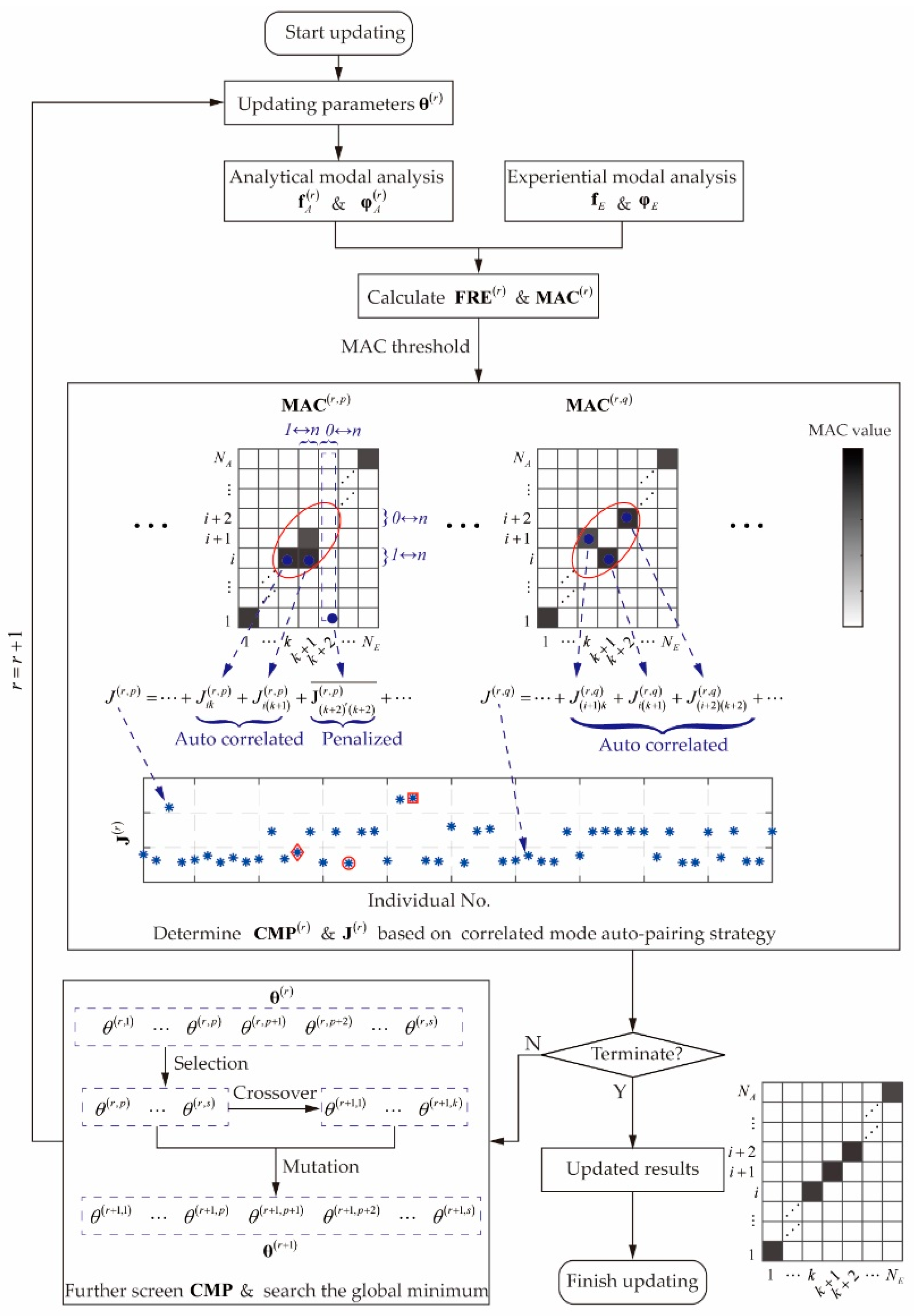


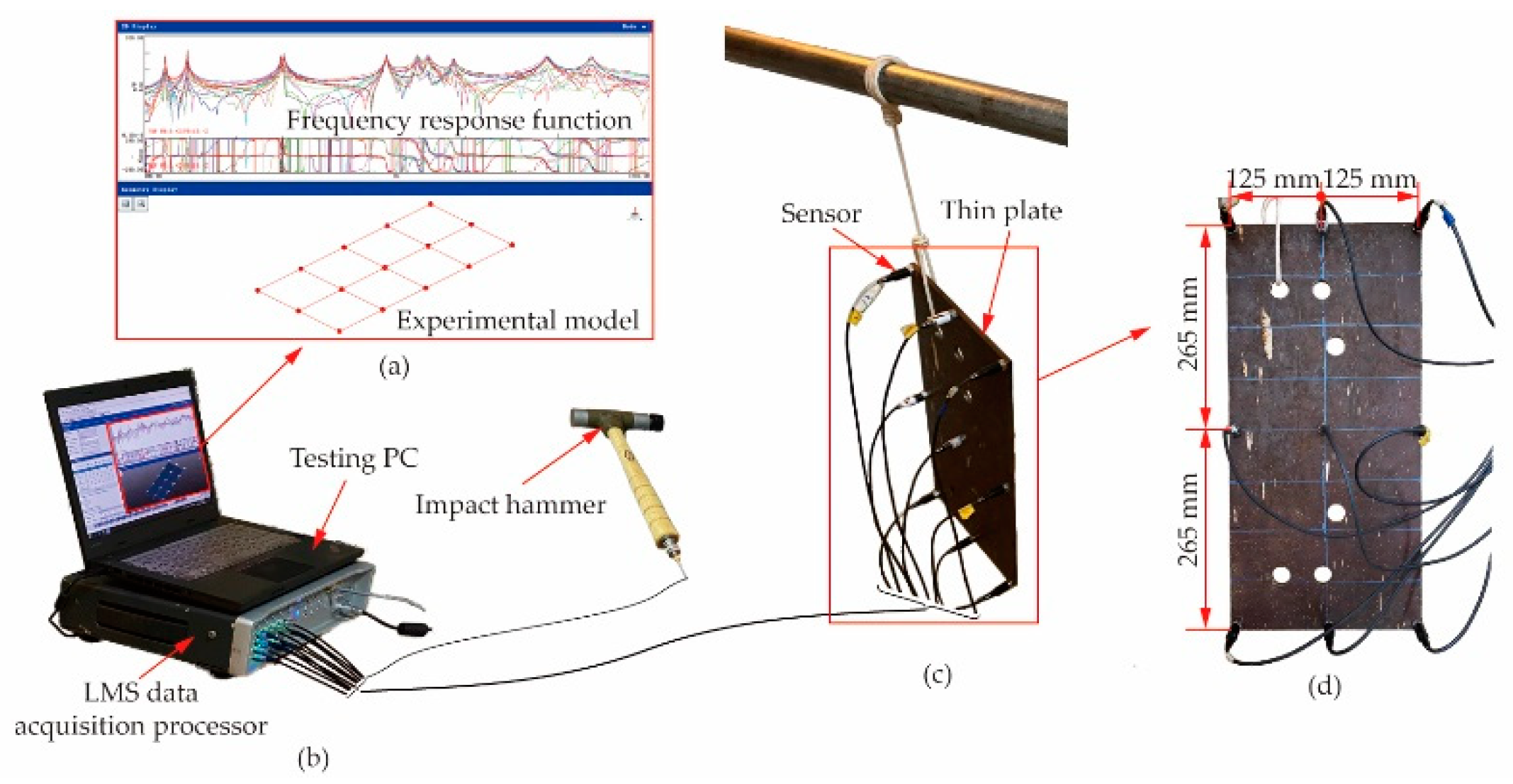
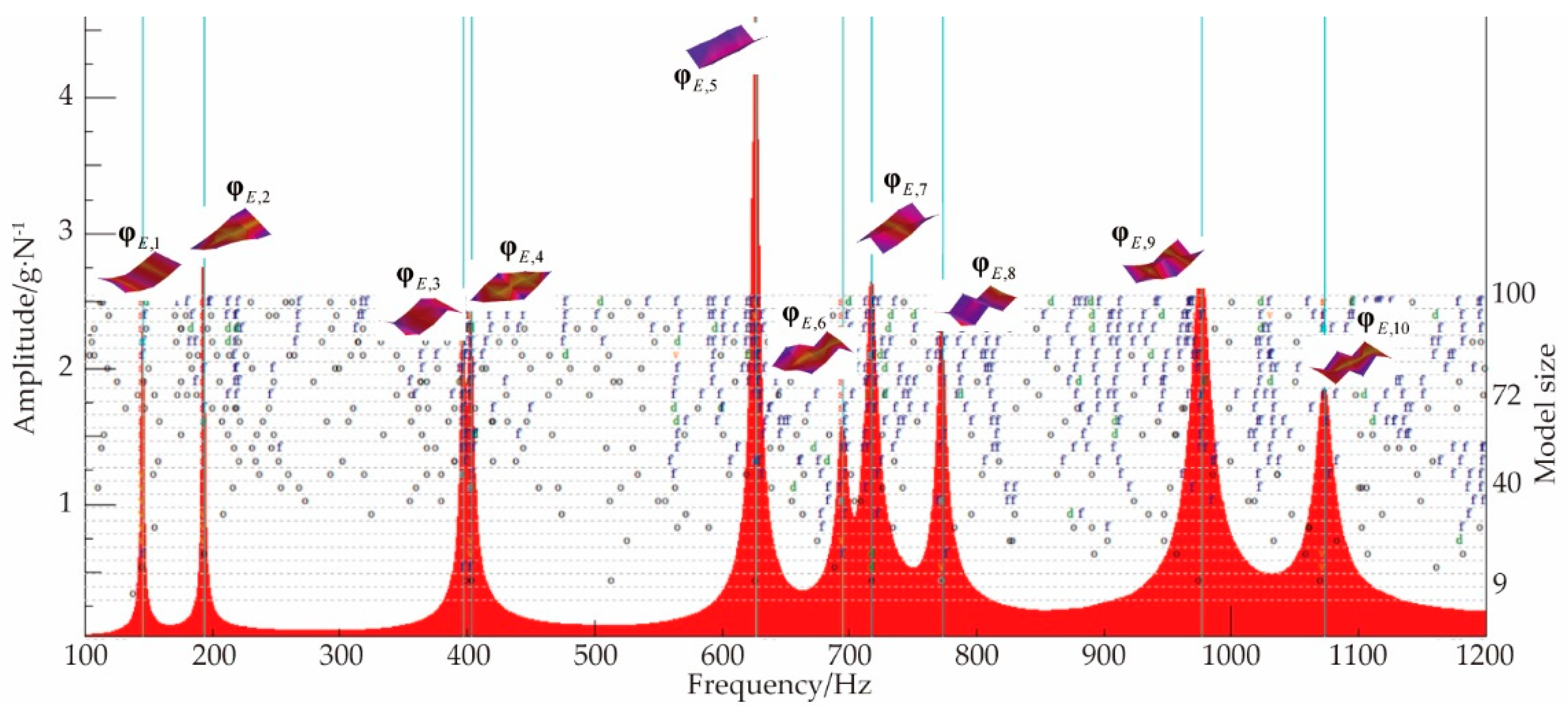
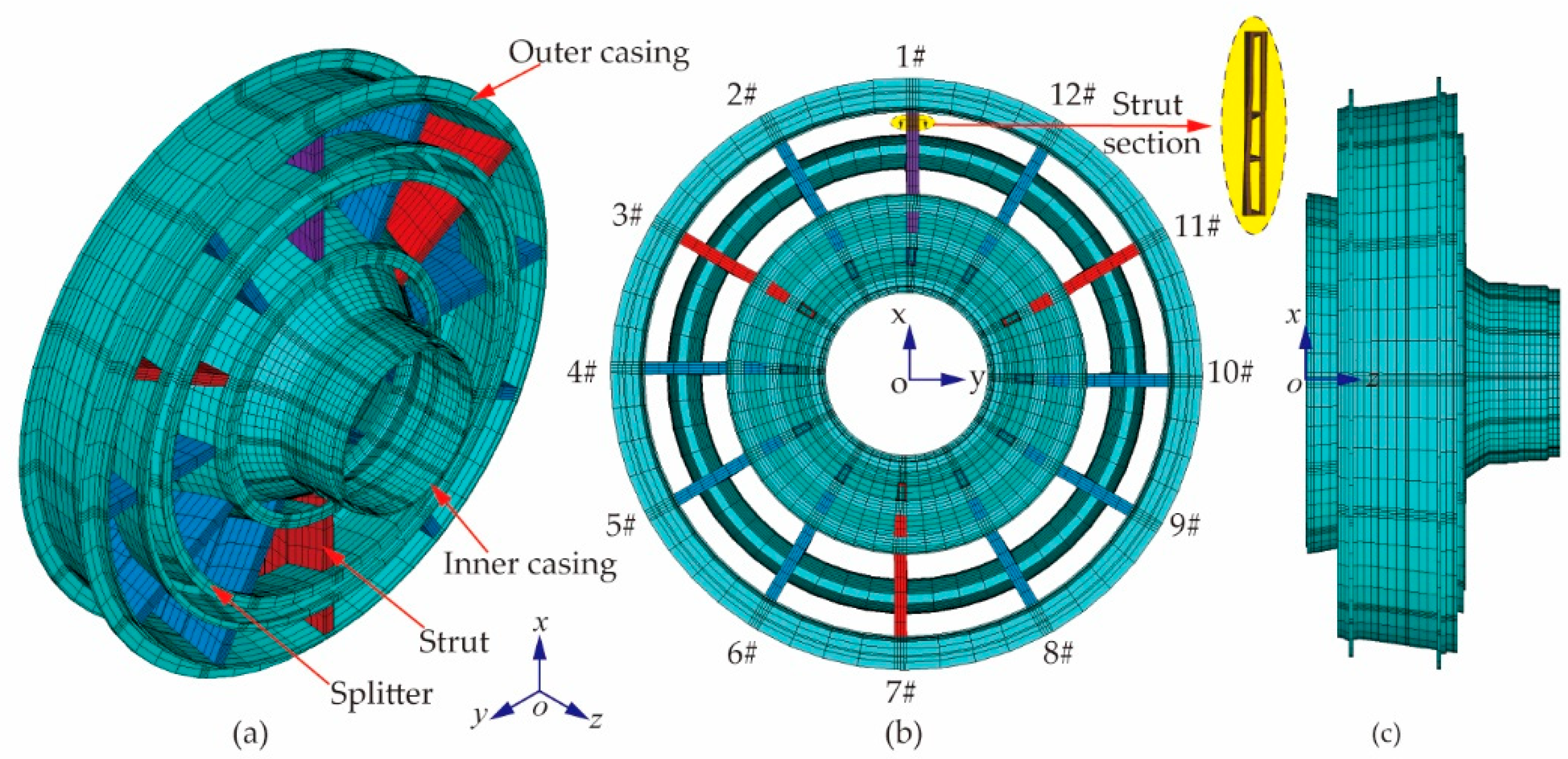

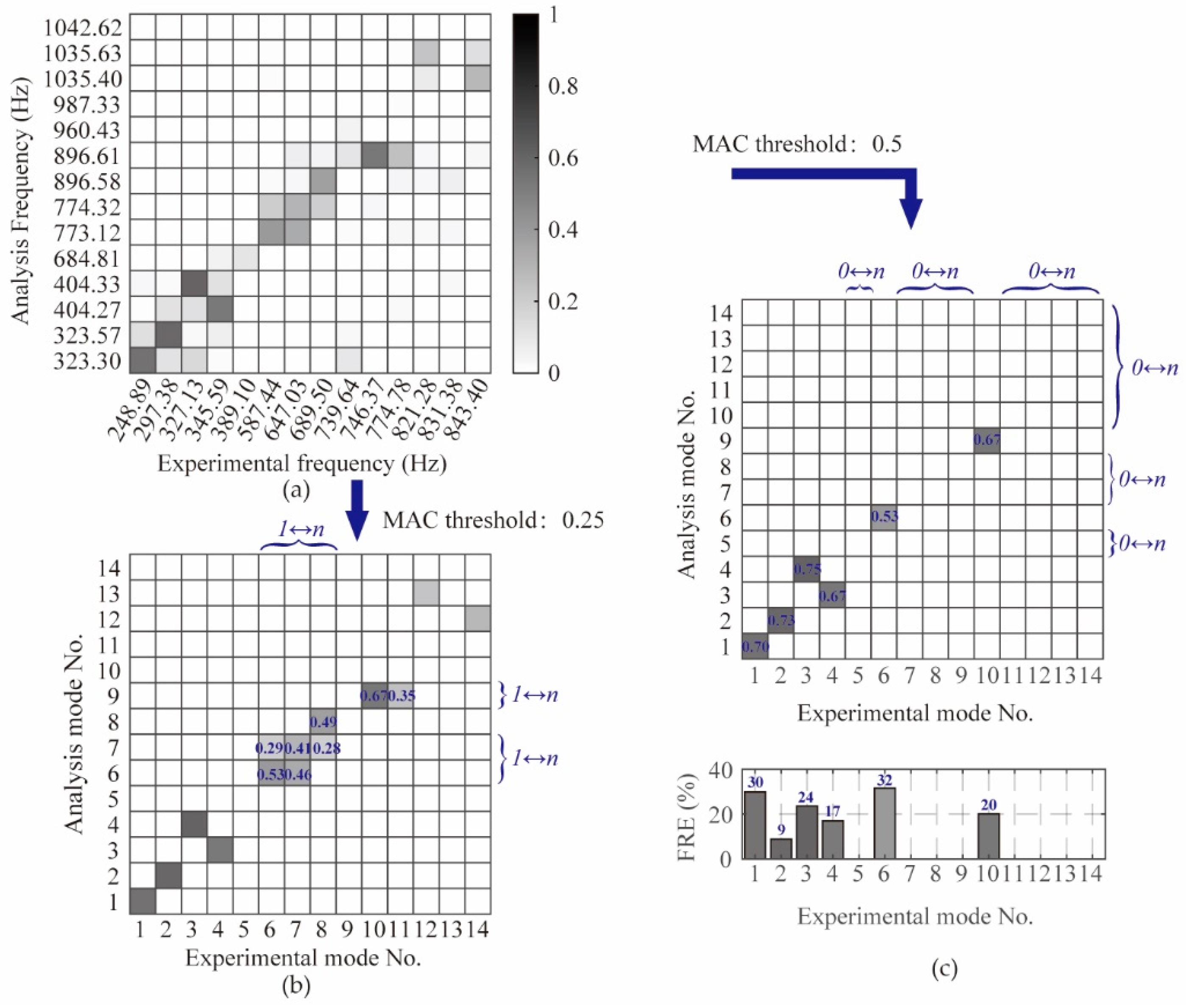
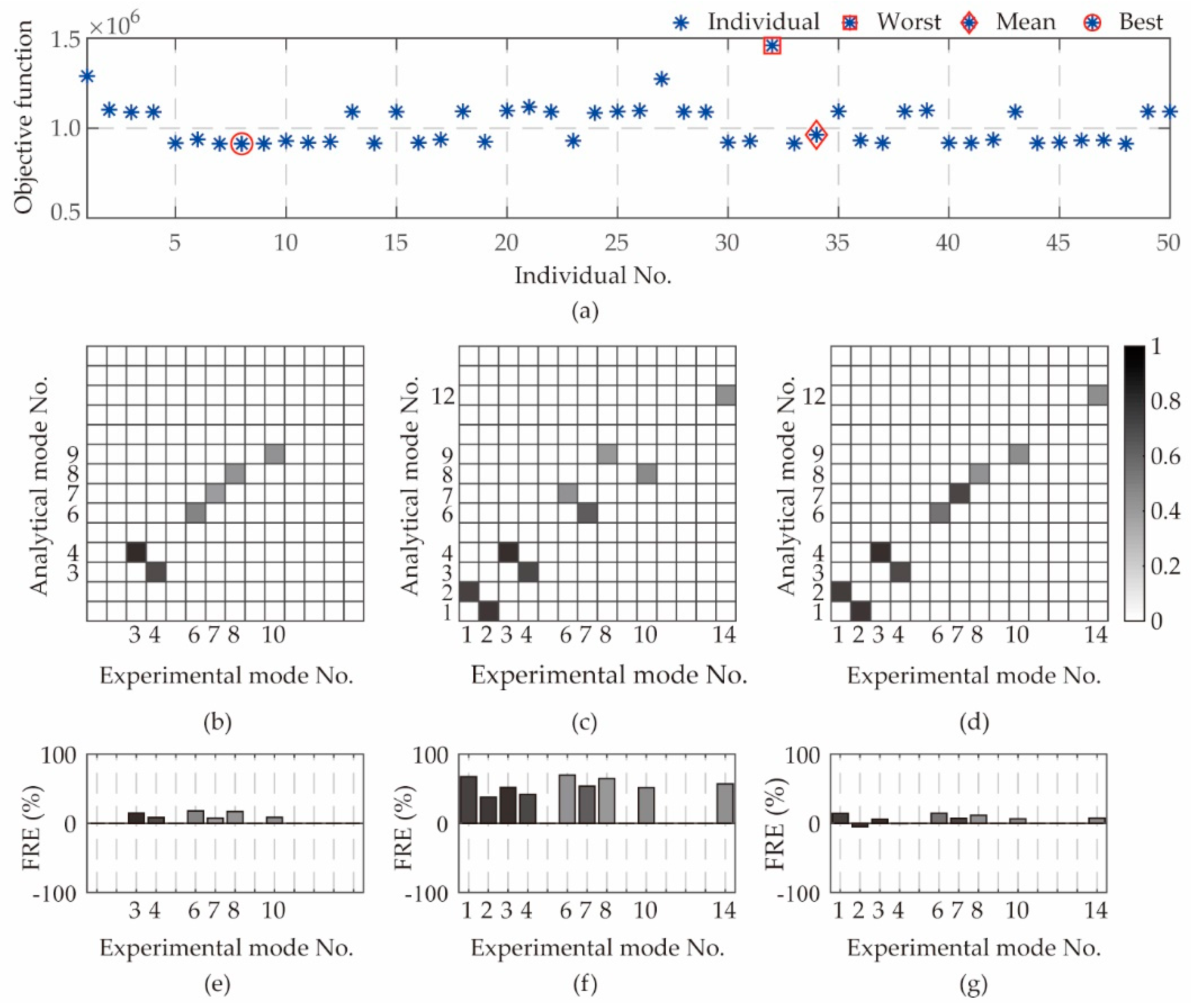
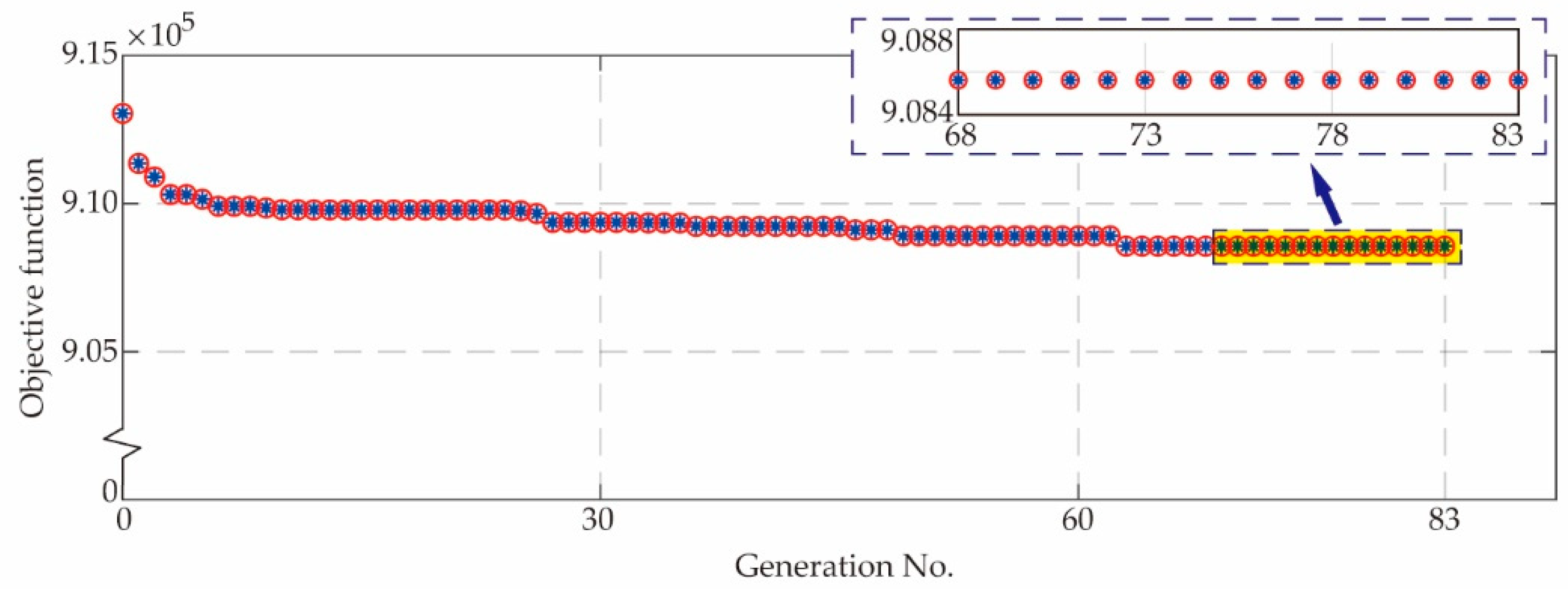

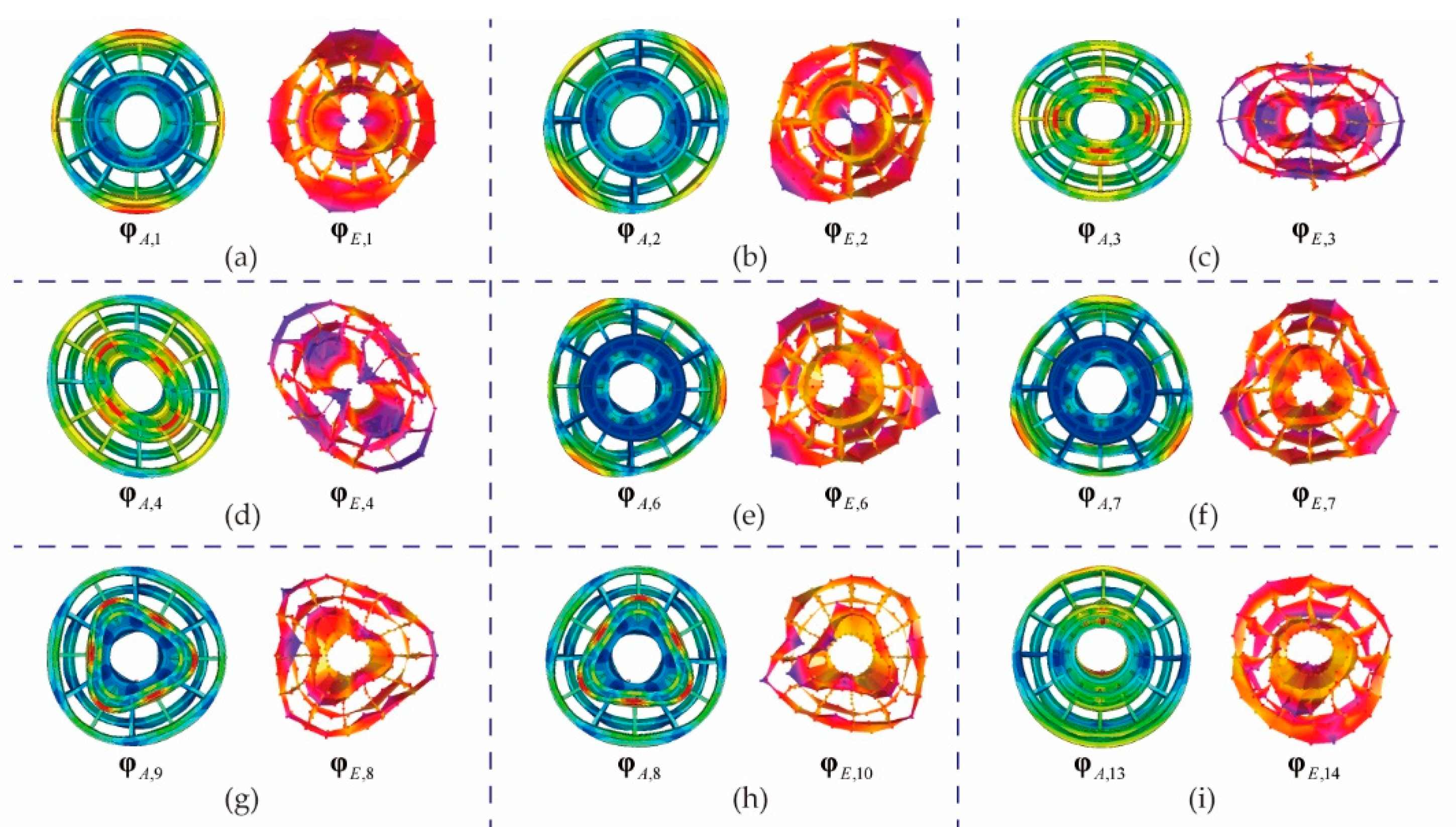
| Model Type | Area Type | Non-Dimensional Ratio of Density | Non-Dimensional Ratio of Modulus of Elasticity | Non-Dimensional Ratio of Poisson’s Ratio |
|---|---|---|---|---|
| Initial FE | Hole | 0.5 | 1.2 | 0.75 |
| Main | 1.0 | 1.0 | 1.0 | |
| ‘Experimental’ | Hole | 0.89 | 1.05 | 0.97 |
| Main | 0.64 | 0.88 | 1.07 |
| Mode No. | “Experimental”Frequency (Hz) | Initial Analytical Modal Analysis | |||
|---|---|---|---|---|---|
| Frequency (Hz) | FRE (%) | MAC | 1-MAC | ||
| 1 | 161.13 | 227.18 | 41.00 | 1.00 | 0.00 |
| 2 | 209.56 | 303.10 | 44.64 | 1.00 | 0.00 |
| 3 | 445.72 | 624.76 | 40.17 | 1.00 | 0.00 |
| 4 | 455.18 | 658.21 | 44.61 | 1.00 | 0.00 |
| 5 | 732.77 | 1016.49 | 38.72 | 0.98 | 0.02 |
| 6 | 780.83 | 1124.19 | 43.97 | 1.00 | 0.00 |
| 7 | 855.55 | 1175.48 | 37.40 | 0.99 | 0.01 |
| 8 | 892.67 | 1222.67 | 36.97 | 0.97 | 0.03 |
| 9 | 1154.68 | 1629.08 | 41.08 | 0.99 | 0.01 |
| 10 | 1219.74 | 1742.04 | 42.82 | 1.00 | 0.00 |
| RMSE | 41.23 | 0.0126 | |||
| CV | 0.0107 | ||||
| Area | Boundary | Non-Dimensional Ratio of Density | Non-Dimensional Ratio of Modulus of Elasticity | Non-Dimensional Ratio of Poisson’s Ratio |
| Main | Lower | 0.1 | 0.1 | 0.1 |
| Upper | 1.5 | 1.5 | 1.2 | |
| Hole | Lower | 0.1 | 0.1 | 0.1 |
| Upper | 1.5 | 1.5 | 1.3 |
| Parameter Name | Value | Parameter Name | Value |
|---|---|---|---|
| Number of individuals | 50 | Migration direction | forward |
| Number of elite | 5 | Migration Interval | 15 |
| Crossover probability | 0.75 | Migration probability | 0.1 |
| Maximum number of generations | 200 | Function Tolerance | 10-6 |
| Mode No. | MUUM | CMPES | ||||||
|---|---|---|---|---|---|---|---|---|
| Frequency (Hz) | FRE (%) | MAC | 1-MAC | Frequency (Hz) | FRE (%) | MAC | 1-MAC | |
| 1 | 162.45 | 0.82 | 1.00 | 0.00 | 161.13 | 0.01 | 1.00 | 0.00 |
| 2 | 211.12 | 0.75 | 1.00 | 0.00 | 209.55 | −0.01 | 1.00 | 0.00 |
| 3 | 449.25 | 0.79 | 1.00 | 0.00 | 445.72 | 0.00 | 1.00 | 0.00 |
| 4 | 458.70 | 0.77 | 1.00 | 0.00 | 455.08 | −0.02 | 1.00 | 0.00 |
| 5 | 738.63 | 0.80 | 1.00 | 0.00 | 732.60 | −0.02 | 1.00 | 0.00 |
| 6 | 787.00 | 0.79 | 1.00 | 0.00 | 780.86 | 0.00 | 1.00 | 0.00 |
| 7 | 861.69 | 0.72 | 1.00 | 0.00 | 855.35 | −0.02 | 1.00 | 0.00 |
| 8 | 899.26 | 0.74 | 1.00 | 0.00 | 892.64 | 0.00 | 1.00 | 0.00 |
| 9 | 1163.85 | 0.79 | 1.00 | 0.00 | 1154.77 | 0.01 | 1.00 | 0.00 |
| 10 | 1229.49 | 0.80 | 1.00 | 0.00 | 1219.92 | 0.01 | 1.00 | 0.00 |
| RMSE | 0.78 | 0.01 | ||||||
| CV | 0.00 | 0.00 | ||||||
| Mode No. | Experimental Frequency (Hz) | Modal Damping Ratios (%) | Initial Analytical Modal Analysis | |||
|---|---|---|---|---|---|---|
| Frequency (Hz) | FRE (%) | MAC | 1-MAC | |||
| 1 | 145.56 | 0.34 | 227.18 | 56.08 | 0.9549 | 0.0451 |
| 2 | 193.65 | 0.24 | 303.10 | 56.52 | 0.9728 | 0.0272 |
| 3 | 397.43 | 0.30 | 624.76 | 57.20 | 0.7745 | 0.2255 |
| 4 | 403.57 | 0.40 | 658.21 | 63.10 | 0.9286 | 0.0714 |
| 5 | 627.03 | 0.32 | 1016.49 | 62.11 | 0.9918 | 0.0082 |
| 6 | 695.33 | 0.50 | 1124.19 | 61.68 | 0.7069 | 0.2931 |
| 7 | 718.01 | 0.55 | 1175.48 | 63.71 | 0.9631 | 0.0369 |
| 8 | 773.24 | 0.41 | 1222.67 | 58.12 | 0.6200 | 0.3800 |
| 9 | 976.84 | 0.62 | 1629.08 | 66.77 | 0.9492 | 0.0508 |
| 10 | 1073.56 | 0.54 | 1742.04 | 62.27 | 0.6504 | 0.3496 |
| RMSE | 60.85 | 0.2038 | ||||
| CV | 0.1724 | |||||
| Mode No. | MUUM | CMPES | ||||||
|---|---|---|---|---|---|---|---|---|
| Frequency (Hz) | FRE (%) | MAC | 1-MAC | Frequency (Hz) | FRE (%) | MAC | 1-MAC | |
| 1 | 141.47 | −2.81 | 0.9489 | 0.0511 | 145.72 | 0.11 | 0.9537 | 0.0463 |
| 2 | 195.02 | 0.70 | 0.9725 | 0.0275 | 183.65 | −5.16 | 0.9716 | 0.0284 |
| 3 | 383.20 | −3.58 | 0.7507 | 0.2493 | 393.05 | −1.10 | 0.7951 | 0.2049 |
| 4 | 413.39 | 2.43 | 0.9301 | 0.0699 | 396.65 | −1.71 | 0.9276 | 0.0724 |
| 5 | 614.27 | −2.04 | 0.9917 | 0.0083 | 632.10 | 0.81 | 0.9842 | 0.0158 |
| 6 | 702.44 | 1.02 | 0.7191 | 0.2809 | 692.68 | −0.38 | 0.7244 | 0.2756 |
| 7 | 722.52 | 0.63 | 0.9723 | 0.0277 | 719.50 | 0.21 | 0.9562 | 0.0438 |
| 8 | 746.54 | −3.45 | 0.6106 | 0.3894 | 766.81 | −0.83 | 0.6559 | 0.3441 |
| 9 | 1019.28 | 4.34 | 0.9588 | 0.0412 | 1029.38 | 5.38 | 0.9437 | 0.0563 |
| 10 | 1087.17 | 1.27 | 0.6394 | 0.3606 | 1094.62 | 1.96 | 0.6657 | 0.3343 |
| RMSE | 2.55 | 0.2082 | 2.55 | 0.1902 | ||||
| CV | 0.1784 | 0.1552 | ||||||
| Group Name | Correlated Mode Pairs | Uncorrelated Mode Pairs |
|---|---|---|
| MUUM | (A1, E1) (A1, E2) (A3, E3) (A4, E4) (A5, E5) (A6, E6) (A7, E7) (A8, E8) (A9, E9) (A10, E10) | (A7, E6) (A6, E7) |
| MUUM-I | (A1, E1) (A1, E2) (A3, E3) (A4, E4) (A5, E5) (A6, E6) (A7, E7) (A8, E8) (A9, E9) (A11, E10) | (A7, E6) (A8, E6) (A6, E7) (A8, E7) (A6, E8) (A7, E8) |
| MUUM-II | (A1, E1) (A1, E2) (A3, E3) (A4, E4) (A5, E5) (A6, E6) (A7, E7) (A8, E8) (A9, E9) | (A7, E6) (A8, E6) (A6, E7) (A8, E7) (A6, E8) (A7, E8) |
| Group Name | RMSEFRE (%) | RMSEMAC | CV | Group Name | RMSEFRE (%) | RMSEMAC | CV |
|---|---|---|---|---|---|---|---|
| MUUM | 2.55 | 0.2082 | 0.1784 | CMPES | 2.55 | 0.1902 | 0.1552 |
| MUUM-I | 6.36 | 0.2147 | 0.1852 | CMPES-I | 2.55 | 0.1902 | 0.1552 |
| MUUM-II | 7.46 | 0.2161 | 0.1870 | CMPES-II | 2.54 | 0.1903 | 0.1552 |
| Mode No. | “Experimental”Frequency (Hz) | MUUM | CMPES | ||||||
|---|---|---|---|---|---|---|---|---|---|
| Frequency (Hz) | FRE (%) | MAC | 1-MAC | Frequency (Hz) | FRE (%) | MAC | 1-MAC | ||
| 1 | 12.01 | 12.17 | 1.34 | 1.00 | 0.00 | 12.01 | 0.00 | 1.00 | 0.00 |
| 2 | 54.73 | 54.86 | 0.24 | 1.00 | 0.00 | 54.73 | 0.00 | 1.00 | 0.00 |
| 3 | 62.38 | 62.52 | 0.21 | 1.00 | 0.00 | 62.38 | 0.00 | 1.00 | 0.00 |
| 4 | 260.71 | 260.85 | 0.05 | 1.00 | 0.00 | 260.71 | 0.00 | 1.00 | 0.00 |
| 5 | 1110.40 | 1110.46 | 0.01 | 1.00 | 0.00 | 1110.41 | 0.00 | 1.00 | 0.00 |
| 6 | 1150.50 | 1150.57 | 0.01 | 1.00 | 0.00 | 1150.52 | 0.00 | 1.00 | 0.00 |
| 7 | 1208.40 | 1208.67 | 0.02 | 1.00 | 0.00 | 1208.37 | 0.00 | 1.00 | 0.00 |
| 8 | 2130.40 | 2130.63 | 0.01 | 1.00 | 0.00 | 2130.46 | 0.00 | 1.00 | 0.00 |
| 9 | 2245.80 | 2245.80 | 0.00 | 1.00 | 0.00 | 2245.77 | 0.00 | 1.00 | 0.00 |
| RMSE | 0.46 | 0.00 | |||||||
| CV | 0.00 | 0.00 | |||||||
| Mode No. | Mode Description | Experimental Frequency (Hz) | Updated Analytical Frequency (Hz) | FRE (%) | MAC | 1-MAC |
|---|---|---|---|---|---|---|
| 1 | Radial | 248.89 | 270.87 | 8.83 | 0.8752 | 0.1248 |
| 2 | Radial | 297.38 | 272.17 | −8.48 | 0.8752 | 0.1248 |
| 3 | Radial | 327.13 | 339.00 | 3.63 | 0.9420 | 0.0580 |
| 4 | Radial | 345.59 | 341.18 | −1.28 | 0.8616 | 0.1384 |
| 5 | Torsional | 389.10 | ||||
| 6 | Radial | 587.44 | 644.32 | 9.68 | 0.7409 | 0.2591 |
| 7 | Radial | 647.03 | 649.33 | 0.36 | 0.8444 | 0.1556 |
| 8 | Radial | 689.50 | 761.62 | 10.46 | 0.5987 | 0.4013 |
| 9 | Axial | 739.64 | ||||
| 10 | Radial | 746.37 | 760.85 | 1.94 | 0.6187 | 0.3813 |
| 11 | Axial | 774.78 | ||||
| 12 | Axial | 821.28 | ||||
| 13 | Local | 831.38 | ||||
| 14 | Radial | 843.40 | 867.74 | 2.89 | 0.6091 | 0.3909 |
| RMSE | 6.50 | 0.2591 | ||||
| CV | 0.1736 |
Publisher’s Note: MDPI stays neutral with regard to jurisdictional claims in published maps and institutional affiliations. |
© 2022 by the authors. Licensee MDPI, Basel, Switzerland. This article is an open access article distributed under the terms and conditions of the Creative Commons Attribution (CC BY) license (https://creativecommons.org/licenses/by/4.0/).
Share and Cite
Shao, H.; Zuo, Y.; Jiang, Z. Dynamic Finite Element Model Updating Based on Correlated Mode Auto-Pairing and Adaptive Evolution Screening. Appl. Sci. 2022, 12, 3175. https://doi.org/10.3390/app12063175
Shao H, Zuo Y, Jiang Z. Dynamic Finite Element Model Updating Based on Correlated Mode Auto-Pairing and Adaptive Evolution Screening. Applied Sciences. 2022; 12(6):3175. https://doi.org/10.3390/app12063175
Chicago/Turabian StyleShao, Huajin, Yanfei Zuo, and Zhinong Jiang. 2022. "Dynamic Finite Element Model Updating Based on Correlated Mode Auto-Pairing and Adaptive Evolution Screening" Applied Sciences 12, no. 6: 3175. https://doi.org/10.3390/app12063175
APA StyleShao, H., Zuo, Y., & Jiang, Z. (2022). Dynamic Finite Element Model Updating Based on Correlated Mode Auto-Pairing and Adaptive Evolution Screening. Applied Sciences, 12(6), 3175. https://doi.org/10.3390/app12063175







